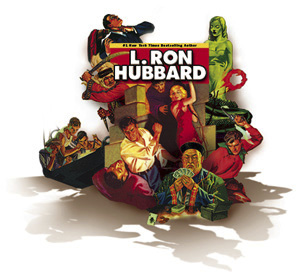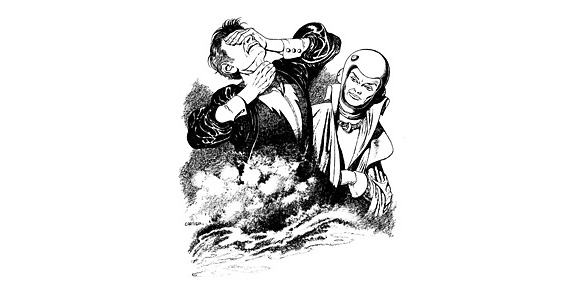One Was Stubbron (11 page)

JOIN THE PULP REVIVAL
America in the 1930s and 40s
 Â
Â
P
ulp fiction was in its heyday and 30 million readers were regularly riveted by the larger than life tales of master storyteller L. Ron Hubbard. For this was pulp fiction's golden age, when the writing was raw and every page packed a walloping punch.
That magic can now be yours. An evocative world of nefarious villains, exotic intrigues, courageous heroes and heroinesâa world that today's cinema has barely tapped for tales of adventure and swashbucklers.
Enroll today in the Stories from the Golden Age Club and begin receiving your monthly feature edition selected from more than 150 stories in the collection.
You may choose to enjoy them as either a paperback or audiobook for the special membership price of $9.95 each month along with FREE shipping and handling.
Call toll free:
1-877-8GALAXY (1-877-842-5299)
Or go online to
www.goldenagestories.com
And become part of the pulp revival!
Prices are set in US dollars only. For non-US residents, please call 1-323-466-7815 for pricing information. Free shipping available for US residents only.
Galaxy Press, 7051 Hollywood Blvd., Suite 200, Hollywood, CA 90028

Glossary
S
TORIES FROM THE GOLDEN AGE
reflect the words and expressions used in the 1930s and 1940s, adding unique flavor and authenticity to the tales. While a character's speech may often reflect regional origins, it also can convey attitudes common in the day. So that readers can better grasp such cultural and historical terms, uncommon words or expressions of the era, the following glossary has been provided.
arc light:
the light produced by a lamp where electric current flows across the gap between two electrodes.
[return to text]
azimuth compass:
a compass with azimuth bearings to indicate direction. Azimuth bearings use all 360° of a compass to indicate direction. The compass is numbered clockwise with north as 0° and then, moving clockwise, due east 90°, due south 180° and due west 270°. So a bearing of 45° would be northeast and a bearing of 225° would be southwest, and so on.
[return to text]
barques:
sailing ships with three to five masts.
[return to text]
beta rays:
streams of particles emitted during radioactive decay.
[return to text]
bilge:
worthless talk; nonsense.
[return to text]
blathery:
unsubstantial; rotten; trashy.
[return to text]
blue eyed:
having or representing childlike innocence.
[return to text]
brass hats:
high-ranking officers.
[return to text]
casque:
any helmet-shaped head covering.
[return to text]
chaw:
a wad of chewing tobacco.
[return to text]
Congressional Medal of Honor:
the highest military decoration in the United States, presented by the president in the name of Congress, to members of the armed forces for gallantry and bravery beyond the call of duty in action against an enemy.
[return to text]
cordial:
a sweet-flavored alcoholic drink usually considered an after-meal beverage.
[return to text]
cordite:
a family of smokeless propellants, developed and produced in the United Kingdom from the late nineteenth century to replace gunpowder as a military propellant for large weapons, such as tank guns, artillery and naval guns. Cordite is now obsolete and no longer produced.
[return to text]
deep-ended:
be in a situation where expertise or experience is required.
[return to text]
emplacements:
prepared positions for weapons or military equipment.
[return to text]
Eternal, by the:
used to express surprise or emphasis;
the Eternal
refers to God.
[return to text]
flimdoodle, don't give a:
variation of “don't give a hoot”;
to not care about something at all.
[return to text]
full astern:
a naval order where the engines are reversed to bring the ship to a stop. Used here to mean “put a stop to.”
[return to text]
G-men:
government men; agents of the Federal Bureau of Investigation.
[return to text]
gouts:
masses.
[return to text]
hackies:
cab drivers.
[return to text]
Japanese moon:
refers to a time of the year when the moon is said to be the brightest and most beautiful, which is celebrated in Japan.
[return to text]
K and D and C
rations:
military combat food introduced by the United States Army during World War II. K-ration: a field or combat ration designed for minimal preparation, using canned, precooked or freeze-dried foods, powdered beverage mixes and concentrated food bars. K-rations were intended to be used for only two or three days, but soldiers being forced to consume them for weeks at a time led to the ration's lack of popularity. D-ration: bars of concentrated chocolate combined with other ingredients to provide a high-calorie content (intended as an emergency ration). C-ration: a complete meal in a can, ready to eat, requiring no special preparation or storage.
[return to text]
lampblack:
a black pigment made from soot.
[return to text]
lewisite:
a colorless or brownish oily poisonous liquid used in gaseous form in chemical warfare.
[return to text]
lucite:
a transparent or translucent plastic.
[return to text]
Madrillon:
the name of a supper club in Washington, DC, that featured Latin music and jazz.
[return to text]
manifestos:
public declarations of policies and aims.
[return to text]
Mussorgsky:
reference to the musical scores “Songs and Dances of Death,” written by Modest Mussorgsky (1839â1881), a Russian composer of operas and orchestral works. He strove to achieve a uniquely Russian musical identity, often in deliberate defiance of the established conventions of Western music.
[return to text]
Old Dutch cleanser:
a white scouring powder used as a sink, stove and tub cleaner in the 1930s.
[return to text]
Ole Mule:
chewing tobacco.
[return to text]
rills:
narrow straight valleys on the moon's surface.
[return to text]
Scheherazade:
the female narrator of
The Arabian Nights,
who during one thousand and one adventurous nights saved her life by entertaining her husband, the king, with stories.
[return to text]
school solution:
the authoritatively announced policies and practices of a group, such as the military way of doing things. Used humorously.
[return to text]
SECNAV:
Secretary of the Navy.
[return to text]
Smyth report:
report written at the end of World War II that told the official story of the making of the atomic bomb. Because it discussed what had been top-secret information, the material it represented was, by definition, no longer classified and could therefore be discussed openly.
[return to text]
sotto voce:
in a low, soft voice so as not to be overheard.
[return to text]
sprites:
small or delicately built people who are likened to elves or fairies.
[return to text]
stroboscopic:
the illusion of a moving or rotating object being stationery.
[return to text]
toils:
an entrapment; something that binds, snares or entangles one.
[return to text]
Tommy gun:
Thompson submachine gun; a light portable automatic machine gun.
[return to text]
transit:
a surveying instrument surmounted by a telescope that can be rotated completely around its horizontal axis, used for measuring vertical and horizontal angles.
[return to text]
Trotskyite:
a supporter of Trotskyism, the political and economic theories of communism as advocated by Leon Trotsky (1879â1940) usually including the principle of worldwide revolution. His politics differed sharply from those of Stalinism and after leading the failed struggle against the policies and rise of Joseph Stalin in the 1920s, Trotsky was expelled from the Communist Party and deported from the Soviet Union. While in exile in Mexico, he was assassinated by a Soviet agent.
[return to text]
Tycho:
a prominent crater on the face of the moon about fifty-six miles in diameter.
[return to text]
vassals:
servants or slaves.
[return to text]
Waldorf:
The Waldorf=Astoria; a famous hotel in New York City known for its high standards and as a social center for the city.
[return to text]
West Point:
US Military Academy in New York. It has been a military post since 1778 and the seat of the US Military Academy since 1802.
[return to text]
